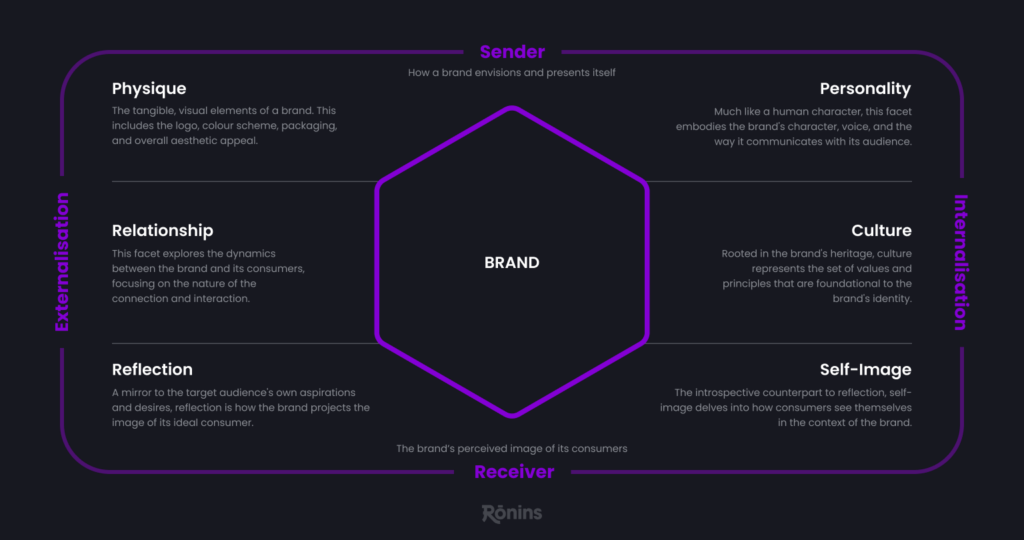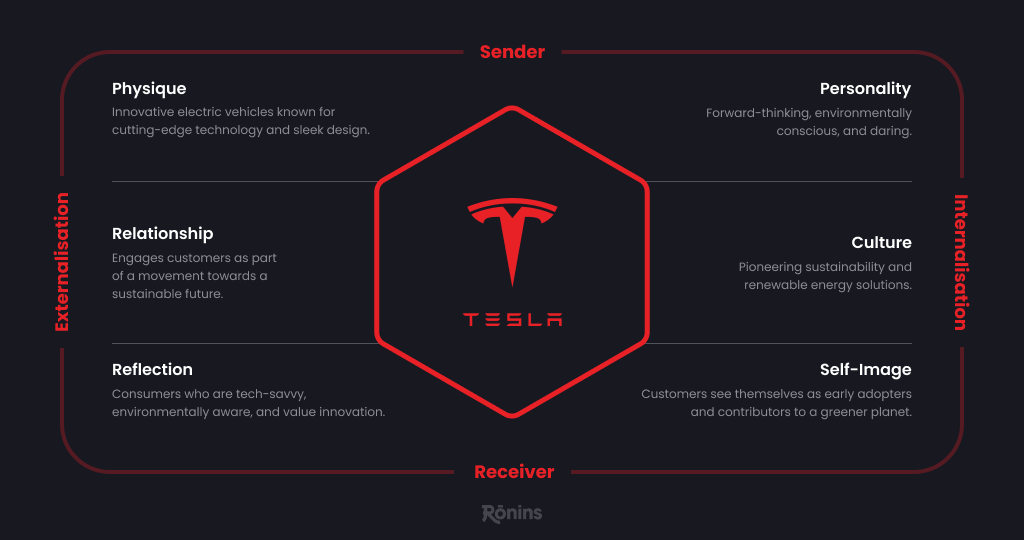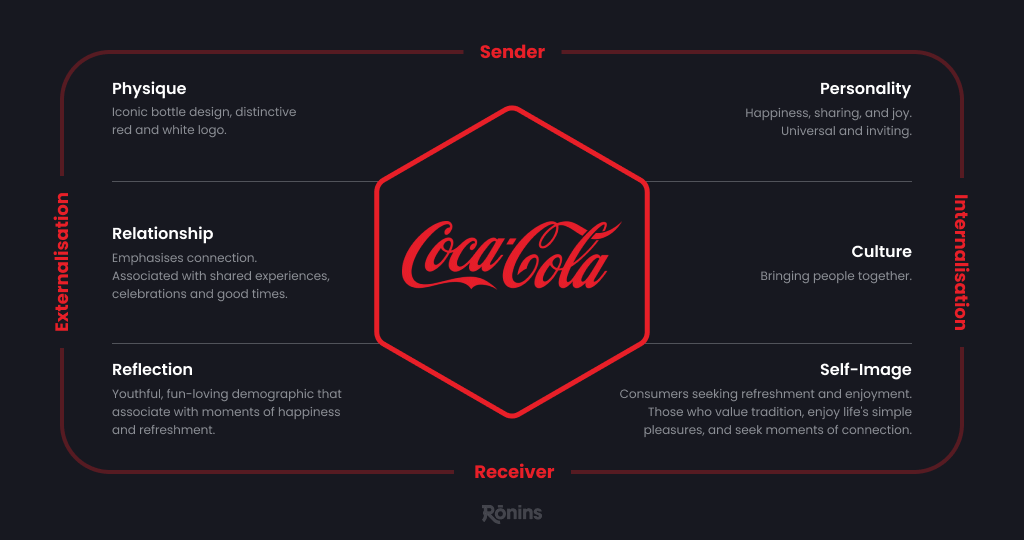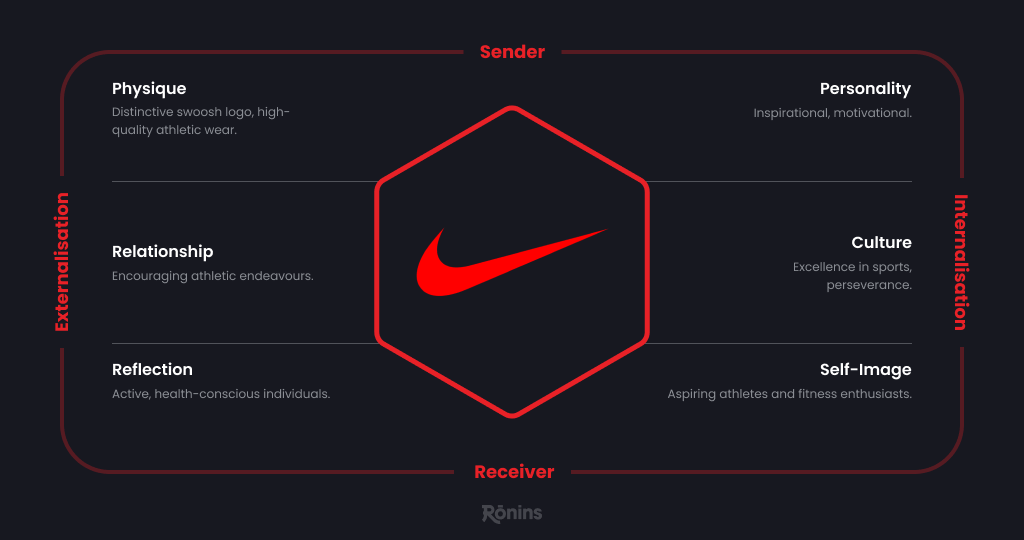
What is the Kapferer Brand Identity Prism?
Table of Contents
Key Takeaways
The Kapferer Brand Identity Prism is a strategic model that outlines six key components of brand identity: Physique, Personality, Culture, Relationship, Reflection, and Self-Image, distinguishing internal and external brand facets for effective brand management.
Strategically applying the Brand Identity Prism facets helps preserve brand consistency across various touchpoints, ensuring the brand’s external image and communication resonate with its internal values and culture.
For successful market positioning using Kapferer’s Prism, brands must develop unique, different, and clear attributes across all six elements, forging a strong identity to distinguish themselves from competitors and aligning their marketing messages to these elements.
Crafting a Powerful Brand Identity with the Kapferer Brand Identity Prism
How can the Kapferer Brand Identity Prism help distinguish your brand and foster a deeper connection with your audience? This article dives into the six defining elements of the prism—Physique, Personality, Culture, Relationship, Reflection, and Self-Image. We’ll show you how these facets work together to form a brand’s character and how to apply them effectively in your brand strategy.
• • •
Deciphering Kapferer’s Brand Identity Prism
Introduced by Jean-Noel Kapferer in 1986, the Brand Identity Prism is a strategic tool that visualises the six key elements composing a brand’s identity. The prism is instrumental in brand strategy as it lays out a roadmap for businesses to define and uniformly exhibit their core values across various touchpoints.
A thoroughly crafted distinctive brand identity through the prism encourages customer commitment and drives the brand’s success by strategically using elements like physique, personality, and culture. Grasping these intricate elements of a brand’s identity is pivotal in moulding your brand’s perception among viewers and achieving a successful brand identity.

Anatomy of the Identity Prism
The Brand Identity Prism breaks down a brand’s identity into six key elements: Physique, Personality, Culture, Relationship, Reflection, and Self-Image. These elements are grouped into two broad categories, Internalisation, involving the elements of Culture and Personality, and Externalisation, which includes Physique, Relationship, Reflection, and Self-Image.
Each component distinctly contributes to a brand’s identity and significantly impacts the audience’s perception of the brand.
Physique – The Visual Identity
The ‘Physique’ refers to the visible design elements of a brand, such as logos, colour palettes, and packaging. These elements provide a first impression, a tangible representation of the brand’s values and differentiate it from competitors. A brand’s physique provides the visual hook that draws consumers in.
Iconic brands like Hermès, Chanel, Ralph Lauren, and Nike have distinctive brand physiques that contribute to their brand identity.
For instance, Nike’s swoosh and Dove’s simple and elegant packaging are key visual aspects that constitute a brand’s physical characteristics. The iconic Apple logo and its minimalist design aesthetic instantly convey sleekness and innovation, embodying the brand’s commitment to user-friendly technology.
These elements are vital in crafting an attractive, cohesive image that strikes a chord with the target audience.
Personality – Infusing Brand Character
A brand’s personality is expressed through the tone and style of visual communications. Defining a tone of voice and integrating it across all communication platforms ensures the brand conveys a consistent message. Elements like colour, typography, and imagery are used to convey character traits like friendliness, sophistication, or innovation.
For instance, Nike’s brand personality is built on individual empowerment and a healthy, active lifestyle. On the other hand, Coca-Cola’s playful personality is communicated through its branding, which combines bold colours, scripted logo font, and messaging focused on enjoyment with friends and family. Red Bull exudes an adventurous, energetic personality, aligning perfectly with its target audience of thrill-seekers and sports enthusiasts.
A distinctive brand personality enhances brand recognition and creates a memorable image for a particular brand.
Culture – Cultivating Brand Culture
This facet is about the deeper meaning and purpose of the brand. The ‘Culture’ of a brand is the underlying value system and principles guiding its behaviour, which should be evident in the brand’s actions and communications. It reflects the brand’s origin story and values, contributing to a purpose beyond the product and influencing its daily operations.
Swedish furniture giant IKEA champions simplicity, cost-effectiveness, and sustainability, a culture that appeals to its globally diverse customer base looking for practical, stylish, and affordable home solutions.
A strong brand culture distinguishes the brand and helps build a strong connection with the target audience.
Relationship – Building Brand Loyalty
This facet focuses on the interaction between the brand and its consumers, looking at the kind of relationship the brand fosters. Whether it’s a friend, advisor, or an innovator, this dimension shapes consumer expectations and loyalty.
Trust in a brand forms the backbone of customer loyalty, impacting receptiveness and purchasing choices. A company must deliver consistently on its brand promise and manage the overall quality of customer experience, from initial interaction through post-purchase support. Engaging customers with personalised experiences via their preferred channels can boost brand-customer relationships.
For example, Amazon’s customer-centric approach, offering convenience, variety and speedy delivery, illustrates a relationship built on trust and reliability.
By focusing on building relationships, brands can foster customer loyalty and drive business success.
Reflection – Reflecting the Ideal Customer
Reflection in branding involves:
- Identifying the ideal customer
- Aligning the brand’s identity towards that audience effectively
- Shaping how customers want to see themselves when using the brand
For instance, companies like Apple and those selling biodegradable cosmetics have successfully crafted a reflection that resonates with their customers’ self-image, such as portraying vibrancy and adherence to a vegan lifestyle, respectively.
Maintaining a consistent reflection allows customers to clearly see how a brand fits into their ideal self-image, fostering a stronger connection with the brand.
Self-Image – Crafting Self-Image Alignment
Branding significantly impacts a customer’s self-image because it influences how they envision their ideal selves. This visualisation plays a crucial role in forming a customer’s relationship with a brand. Brands should address these aspirations to build a significant connection. For example, if a brand markets fitness products, its branding endeavours should reflect the healthy, active lifestyle desired by its target customers.
Brands can strengthen their market position by ensuring their messaging is in line with the ideal identity of their customers, tailoring marketing messages to resonate with the customers’ internal perceptions. Incorporating self-image into a brand’s identity can result in increased customer loyalty and better business performance.
• • •
The Interplay Between Internalisation and Externalisation
The interplay between Internalisation and Externalisation in the Brand Identity Prism ensures a seamless brand identity.
Internalisation involves a brand’s self-perception, including its values and personality, while externalisation addresses how the brand presents itself to consumers through aspects like its visual identity and marketing efforts.
For a strong brand identity, aligning a brand’s core values and culture with its external communication and customer interactions is essential. This ensures uniformity at every point of contact. A cohesive brand identity emerges when a brand successfully integrates Kapferer’s six Identity Prism dimensions, showcasing genuine internal culture alongside a meaningful external presence and customer relationship.
• • •
Kapferer Brand Identity Prism Examples
Looking at major brands through the lens of the prism reveals how their identities are constructed. These illustrations demonstrate how each brand embodies the six key elements of the prism to establish their unique positions in the marketplace, revealing insights into how they connect deeply with their audience and differentiate themselves from competitors.

Tesla’s physique includes its sleek, aerodynamic car designs. Its personality is innovative, future-focused, and pioneering. Tesla’s culture involves environmental sustainability and technological vision. The brand relationship involves customer participation in beta testing new features. Tesla’s reflection combines luxury and environmentalism. And its self-image is that of being a leader in sustainable transportation.

Coca-Cola’s prism similarly showcases its iconic bottle physique, fun personality, inclusive culture, nostalgic relationship with customers, reflection of Americana, and self-image as an uplifting, refreshing drink.

Nike’s prism includes its “swoosh” logo physique, competitive personality, sports culture, relationship with star athletes, reflection of achievement, and self-image as fuel for aspiration.
• • •
Strategic Application of the Identity Prism
Strategically applying the Identity Prism entails individually evaluating each facet and merging them into the comprehensive brand strategy to preserve a consistent persona and unified communications. A personalised Brand Identity Prism can guide marketing communications and strategic decisions, positioning the brand consistently with its business objectives.
Understanding how the brand identity prism works is essential for achieving these goals. Visualising a brand via the prism requires evaluating each component with targeted questions that align with the brand’s core mission and values. This helps to guide marketing communications and strategic decisions. The Brand Identity Prism serves as a checklist to highlight a brand’s strengths and weaknesses, aiding in the organisation of marketing strategies and communication planning.
For instance, crafting a brand’s mission statement and buyer personas that underpin strategic branding decisions can be facilitated by envisioning the brand through the prism. Using the prism effectively can help brands maintain agile and relevant marketing strategies, improving their overall brand identity and market positioning.
How to Apply the Prism and Envision Your Brand
Understanding the Kapferer Brand Identity Prism provides a strategic framework for both new and established brands to shape and refine their identity. Leverage the Prism to ensure your online presence is deeply aligned with your brand values and customer expectations. Here’s how businesses can leverage the prism to enhance their brand’s resonance with its audience:
For New Brands: Building a Foundation
- Start with Culture: Define the core values and mission that your brand stands for. This sets a solid foundation for your brand’s identity.
- Design the Physique: Create a visual identity that reflects your brand’s culture and values. This includes your logo, colour scheme, and packaging.
- Craft the Personality: Decide on a voice and communication style that personifies your brand, ensuring consistency across all channels.
- Establish Relationships: Consider the kind of relationship you want to build with your audience. Is your brand more of a mentor, friend, or advisor?
- Reflect and Self-Image: Identify your target audience and understand their aspirations and self-perception. Tailor your messaging to mirror these aspirations and appeal to their self-image.
For Established Brands: Reassessment and Realignment
- Audit Your Brand: Use the prism to evaluate your current brand identity. Does each facet accurately reflect the brand you want to be?
- Identify Gaps: Look for inconsistencies or gaps between your brand’s self-presentation and consumer perception.
- Update the Physique: Refresh your visual elements if they no longer align with your brand’s culture or have become outdated.
- Realign Personality and Culture: Adjust your communication style and reaffirm your brand’s values to ensure they resonate with your target audience.
- Strengthen Relationships: Enhance your engagement strategies based on consumer feedback and changing dynamics.
- Adapt to Consumer Aspirations: As societal values and consumer aspirations evolve, ensure your brand’s reflection and self-image adapt accordingly.
• • •
Leveraging the Prism for Market Positioning
Leveraging the Prism for market positioning involves ensuring all six elements are unique, different, and clear, creating a lasting position in the market and distinguishing the brand from competitors.
For instance, Land Rover projects a clear brand identity emphasising their off-road capability, rugged and honest design, and heritage, reinforcing their competitive positioning.
Integrating the Prism into Your Marketing Messages
Weaving the Prism into marketing messages necessitates aligning all marketing communication aspects with the prism’s six elements, guaranteeing coherent and steady messaging that appeals to the target audience.
A comprehensive review of marketing materials and design assets against the Kapferer Brand Identity Prism can reveal inconsistencies or misalignments within the brand’s visual identity, allowing for targeted refinement.
For instance, integrating the Prism into marketing messages can significantly enhance the brand’s market positioning and customer loyalty. Some strategies to achieve this include:
- Creating relevant and valuable content, such as blog posts and videos, to demonstrate industry expertise and problem-solving skills
- Active engagement with customers on social media platforms
- Providing prompt responses to customer inquiries
- Reinforcing trust and revealing the human element behind the brand
By implementing these strategies, successful brands can cultivate trust and build strong relationships with their customers.
Brand Identity Prism Template
Download our free Brand Identity Prism template to help envision and craft each facet of your brand’s identity. Use it to map out your own cohesive and resonant brand identity that truly stands out in the market.
• • •
Wrapping Up
The Kapferer Brand Identity Prism is a powerful strategic tool that helps businesses define and consistently display their core values. By focusing on six prism facets, brands can create a strong and unique brand identity that resonates with their target audience.
With this prism, brands can effectively guide their marketing communications and strategic decisions, ensuring a coherent brand image and fostering customer loyalty.
Understanding the Kapferer Brand Identity Prism can significantly influence how your brand is perceived online, which is crucial for sectors like web design where first impressions on digital platforms matter immensely.
The Kapferer Brand Identity Prism is not a one-time checklist but a continuous strategic tool for brand development. It requires regular reflection and adaptation to changes in the market, consumer expectations, and societal values.
By systematically applying and revisiting each facet of the prism, brands can maintain relevance, foster deep connections with their audience, and ultimately achieve enduring success.
• • •
Frequently Asked Questions
What is the Kapferer brand identity prism?
The Kapferer brand identity prism is a marketing model that visualises the six key elements of a brand identity, helping businesses build strong and enduring brand identities that reflect their core values.
What are the 6 brand identity prisms?
The 6 brand identity prisms include physique, personality, culture, relationship, reflection, and self-image. They help you unify the voice and personality of the brand, pushing you to think cohesively about your brand.
How can the Prism be used in strategic brand management?
The Prism can be used in strategic brand management to guide marketing communications and strategic decisions, ensuring a coherent and consistent brand image that resonates with the target audience.
What is the role of ‘Culture’ in a brand’s identity?
Culture plays a significant role in shaping a brand’s identity by reflecting its origin story and values and guiding its purpose and operations.
Need help defining your brand’s identity?
Ready to translate brand theory into reality? Connect with us, and we’ll help build an identity that resonates across all your markets.





